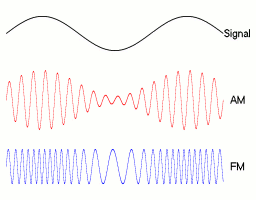How the telephone works Updated 2025-07-16
- www.quora.com/How-is-a-voice-transmitted-from-one-phone-to-another
- www.quora.com/How-many-wires-does-a-telephone-use/answer/Peter-Yardley-1
Basic analogue phones connected to the public exchange use two wires mainly arranged as a twisted pair to reduce noise. The voice signal is differential (the voltage in one wire equal and opposite to the other) biased above ground by 48V. Using a twisted pair reduces induced noise because the noise signal will induce an equal voltage in each wire and because the signal is transmitted as the difference the effect of the induced noise will be dramatically reduced.
Phone Intercom by Make (2014)
Source. This video illustrates will the incredible simplicity of the connection of a telephone system. Compare that to the relative complexity of wireless communication, which requires modulation. Modulation Updated 2025-07-16
But now people want to send voice. How to do it?
It would not be practical without modulation: Why can't you send voice without modulation?
Spark-gap transmitter Updated 2025-07-16
The first type of device that allowed sending Morse code without wires, as opposed to the wired electrical telegraph that previously existed.
Wireless voice transmission came about with modulation.
Telephone Updated 2025-07-16
Also wired phones don't require modulation, which likely made their development much easier than wireless voice transmission. You just send the signal as a voltage differential directly obtained from the air pressure: how the telephone works.
